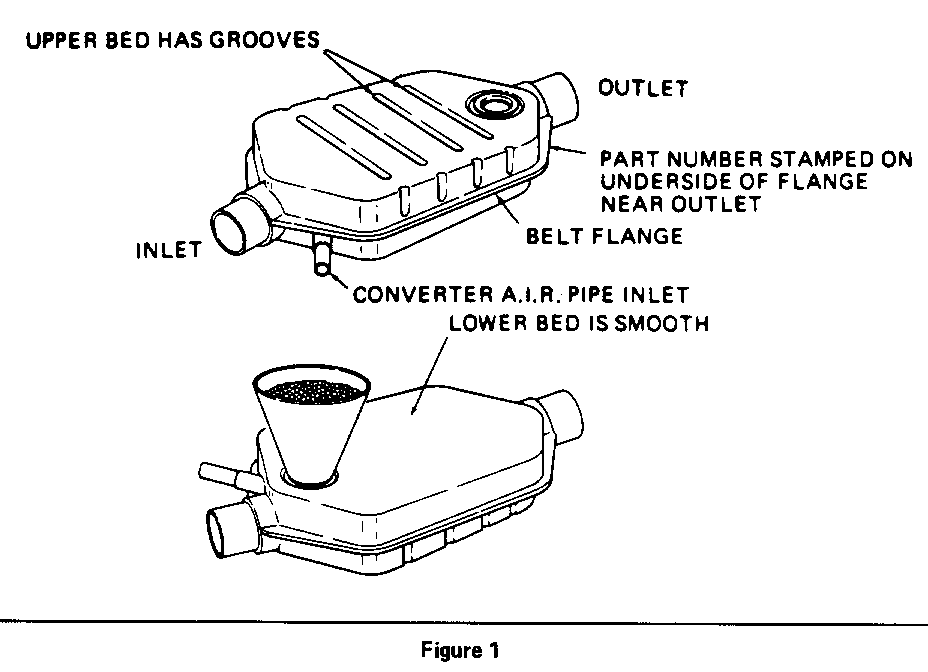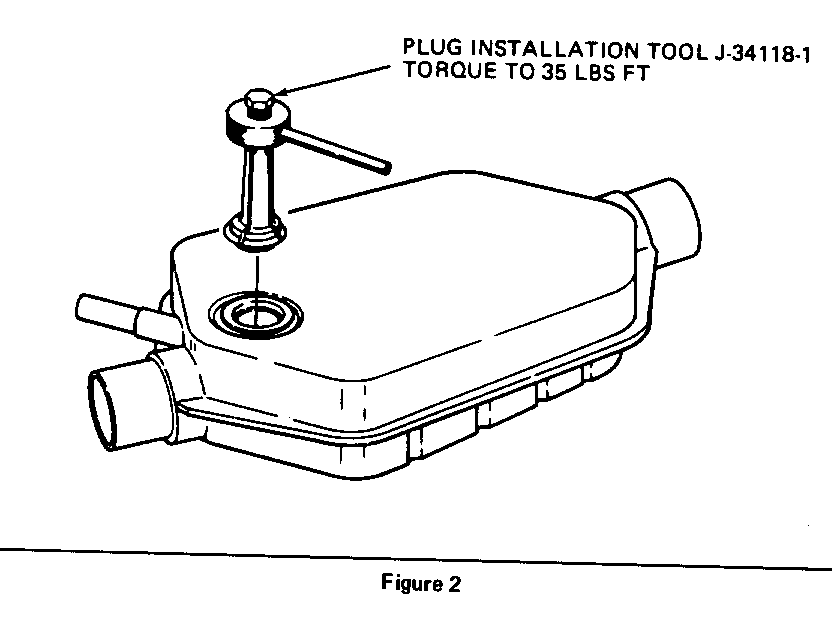RESTRICTED EXHAUST PLUGGED CATALYTIC CONVERTER

VEHICLES AFFECTED: 1983 Models Equipped With 4.1L (VIN Code 4) V-6 Engines
Some 1983 vehicles produced prior to March 1983 and equipped with 4.1L V-6 engines may develop a restricted exhaust due to the catalytic converter becoming plugged. This can result in poor engine performance or a no-start condition.
Effective with this bulletin, subject vehicles, which are determined to have a restricted converter, are to be repaired with the converter kit package which includes a converter shell with beads in the upper bed and a plug for sealing the lower bed after installing beads per the instructions in this bulletin.
PARTS INFORMATION
Parts are to be obtained from CMWDD using the following part numbers:
DESCRIPTION PART NUMBER ----------- ----------- Kit, Catalytic Converter with Upper 25056983 Beads (Includes converter number 25056905, fill hole plug 8998202 and instruction sheet.)
*Package, Lower Bed Bead 25056903 (As needed to Fill Converter)
Clamp, Converter Front Exhaust 1259609 (if needed)
Bolt, Intermediate Exhaust Pipe to 11502877 Converter (Two per vehicle, if needed)
Bolt, Exhaust Hanger to Converter 11504596 (Two per vehicle, if needed)
A lower Bed Bead package, when used along with the beads removed from the old converter, will complete approximately ten (10) vehicles.
Additional fill hole plugs, if required, may be ordered using Part Number 8998202.
SPECIAL TOOLS
A. Converter Bead Replacement Tool Kit
Each Zone Office was shipped during March 1983, one (1) complete catalytic converter bead replacement tool kit J-34155 for each Territory. Each kit consists of:
J-34155-1 Sifting Pan (1) J-34155-2 Storage Pans (2) J-34155-3 Funnel (1)
In the event kits are required by the Dealer, they may be obtained from the local Zone Office or purchased from:
Kent-Moore Tool Division
CATALYTIC CONVERTER REPLACEMENT PROCEDURE
CAUTION:
The catalytic converter beads contain platinum, palladium, and/or rhodium. Additionally, the beads may be finely coated with lead compounds. Therefore, precautions should be taken to mininize dust generation during the replacement procedure. These precautions include:
Catalyst dustt should be controlled by wetting with water prior to bead removal, as described in Step 4.
The use of a suitable dust mask, rubber gloves, and safety glasses is recommended when handling catalyst beads.
Allow converter to cool before handling.
1. Loosen clamp and disconnect AIR pipe from converter.
2. Disconnect intermediate exhaust pipe and hanger from rear of converter.
3. Remove clamp and disconnect converter from front exhaust pipe.
4. Stand the old converter upright on the inlet end and pour 16 ounces of water into the outlet end to control catalyst dust.
5. Using a hammer and chisel, remove the fill hole from the lower bed (the smooth side of the converter is the lower bed side). See Figure 1.
6. Hold the converter over a clean pan (J-34155-2) and empty the catalyst beads by shaking.
It may be necessary to tap the converter belt flange with a hammer to loosen the beads.
7. Pour the beads into a sifting pan (J-34155-1) and sift to remove undersized beads.
8. Prop the new converter up at a 45-degree angle with the lower bed fill hole at the top.
9. Using funnel J-34155-3, pour the sifted beads into the lower bed of the new converter (see Figure 1). Tap belt flange with rubber mallet to allow beads to settle. Continue filling and tapping until converter is full. If additional beads are required to completely fill the lower bed, it will be neceseary to obtain a lower bed boad kit from the Parts Department.
Excess beads from the kit should be saved in a clean container for future use.
10. Lay the converter down on a flat surface with the lower bed fill hole on top.
11. Insert the fill plug into the lower bed fill hole. The fill plug outer rim must rest against the converter body.
12. Insert tool J-34188 into fill plug and tighten to a torque 47 N.m (35 lb. ft.) (see Figure 2).
13. Install new converter in vehicle reversing removal procedure (Steps 1, 2, and 3) and using new bolts and clamp as required. Torgue front clamp nuts to 35 N.m (26 lb. ft.), intermediate pipe to converter bolts to 20 N.m (15 lb. ft.) and hanger to converter bolts to 52 N.m (38 lb. ft.).


General Motors bulletins are intended for use by professional technicians, not a "do-it-yourselfer". They are written to inform those technicians of conditions that may occur on some vehicles, or to provide information that could assist in the proper service of a vehicle. Properly trained technicians have the equipment, tools, safety instructions and know-how to do a job properly and safely. If a condition is described, do not assume that the bulletin applies to your vehicle, or that your vehicle will have that condition. See a General Motors dealer servicing your brand of General Motors vehicle for information on whether your vehicle may benefit from the information.
